Products are made of language, not code
This post has moved to the Orbit blog.
This post has moved to the Orbit blog.

This post has moved to the Orbit blog.
I wasn’t really thinking about AI. In 2022, I’d had my big realisation that what was making me effective in marketing might be even more valuable in product work. And at the start of 2023, I’d worked my way up through the gears building out my first
(or how I learned to stop spending Lovable credits and love the terminal.)
"As a blue collar tradesperson, I literally only trust word of mouth." In just 24 hours, this became the top reddit vote on a thread I posted asking why there's no product that reduces the mental load of looking after your home. It's not